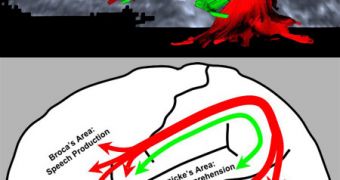The complex human speech is one of the most important traits that differentiate us from animals. It relies on our large brains, however it is not a question of size but of brain wiring, as showed by a new research published in "Nature Neuroscience."
Since the 19th century, the Broca nucleus in the frontal cortex and Wernicke nucleus in the temporal cortex have been connected to language. The first area has an important role in building and understanding phrases, the latter in understanding the meaning of the words (apes and monkeys have these nuclei, but they have other functions). Recent researches have showed that speech is a function demanding close communication between various language nuclei.
If the arcuate fasciculus, made of bundles of nerve fibers connecting Broca's and Wernicke's nuclei, is harmed, the person will experience profound difficulty in speaking and understanding speech. Other researches show that we have a different wiring compared to apes and monkeys.
The team led by anthropologist James Rilling of Emory University in Atlanta, Georgia, used the diffusion tensor imaging, which takes pictures of tissues based on the flow of water within them, to achieve a detailed image of nerve fibers connecting various brain nuclei.
The brain scanning was made on 10 live humans, three deceased chimpanzees and two deceased macaque monkeys. One live chimpanzee and one live macaque were brain scanned to check if the chemicals employed to preserve the dead brains had altered the brain structure.
The arcuate fasciculus appeared to differ significantly in humans compared to apes and monkeys. In all three species, the fascicle was hooked up to the frontal cortex, including the human Broca nucleus, but only in humans it prolonged deeply into speech-connected areas of the temporal cortex, like Wernicke's area.
The arcuate fasciculus of the chimpanzees made just a low connection with the temporal cortex area corresponding to human Wernicke's area, while in macaques such connections were almost totally inexistent. It seems that the evolution of the human complex speech has been associated with massive new wiring made by the arcuate fasciculus.
The apes' inability to speak has been stressed too much on their vocal chords, larynx and mouth structure. On the other hand, their intelligence has been compared to that of a 6-year-old child, thus they could speak. They can easily learn the sign languages, but this new approach explains why speech is out of their reach.
It shows "the uniqueness of the human brain, because it has been widely assumed that the basic brain structures are essentially similar between humans and apes," said Kuniyoshi Sakai, a language researcher at the University of Tokyo, in Japan.
Some ask for even more ample research on this area.
"The approach should be repeated with more samples before drawing firm conclusions," said Thomas Schoenemann, an anthropologist at James Madison University in Harrisonburg, Virginia.

 14 DAY TRIAL //
14 DAY TRIAL //